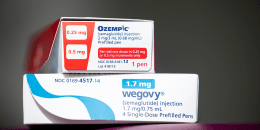Do ice baths have benefits for health, or are they just another over-hyped wellness trend? Ice baths are not new, but they have become increasingly popular in recent years. The freezing plunge is a fixture at many spas and wellness clubs, and you can even order portable ice bath tubs for your home.
Proponents claim the toe-numbing practice has a host of physical and mental benefits, from fighting inflammation to improving mood. They're also a favorite ritual among athletes, who take the plunge after workouts to relieve soreness and improve recovery.
Many high-profile celebrities have touted their love of ice baths on social media, from Lady Gaga to Kim Kardashian and Harry Styles.
Actor Mark Wahlberg told TODAY he starts every morning with an ice-cold soak, and R&B singer Usher said he loves ice baths so much that he keeps a portable tub backstage at his Las Vegas residency to rejuvenate between shows.
Celebrity endorsements and online buzz aside, is subjecting yourself to all the shivering and discomfort worth it?
We spoke to Dr. Dominic King, a sports medicine physician in the department of orthopedic surgery at the Cleveland Clinic, to find out what ice baths actually do to the body, whether there are benefits or risks, and how to try them safely.
What is an ice bath?
Also known as “cold water immersion,” ice baths involve submerging the body into an bath of icy, cold water for a brief period of time, usually around three to five minutes.
Ice baths are not new, but they have come in and out of popularity in recent years, King tells TODAY.com. What we know as the modern ice bath has evolved over thousands of years.
Humans have been using the cold for therapeutic purposes, which is called "cryotherapy," dating back to 3500 B.C., according to an article published in the Journal of Applied Physiology.
What do ice baths do to the body?
What happens to the body in an ice bath is straightforward, said King. First, the cold water causes an immediate circulatory response.
The blood vessels in the parts of the body submerged will constrict, King said. When blood vessels constrict, blood doesn’t flow as quickly to those areas, which lowers the temperature of the body's tissues. This typically occurs in the extremities first, King noted — this is because blood moves to core of the body, where heat is held, to keep the vital organs warm.
“If it’s your entire body (submerged in icy water), you’re going to get constriction of those blood vessels throughout your body," King said. Generally speaking, less blood flow also means less swelling and reduced inflammation — at least temporarily, King adds.
Ice baths may cause a sudden increase in breathing, heart rate and blood pressure, known as a “cold shock response,” TODAY.com previously reported. This response may also include muscle spasms, shivering and gasping.
The sensation of plunging into the freezing water can also trigger a rush of stress hormones, such as cortisol, and endorphins.
After the initial cold shock, the body may start to calm down and acclimate to the cold — breathing exercises and distraction methods can help this process. When you get out, the blood vessels will dilate or widen and blood flow will return to the body tissues and extremities, causing the internal temperature rise again.
The benefits of ice baths
There are many claims about the benefits of ice baths, but are any of these backed up by science? Historically, the science behind the effects of ice baths has been “pretty mixed,” said King. Some studies even suggest that there is a placebo effect at play.
Overall, there is a lack of robust scientific evidence to support many claims about ice baths, and research on the uses and benefits is still emerging. However, there are some studies which suggest that ice baths may have some benefits for certain people.
Exercise recovery
Ice baths are a popular post-exercise cooldown method. Many athletes plunge into icy water after intense training to ease sore muscles, relieve swelling and improve recovery, said King.
The evidence to support these claims has been debated, but a systematic review published in the journal of Sports Medicine in January 2022 suggests ice baths may be beneficial, especially for people who do high-intensity exercise, King noted.
“It showed that cold water immersion was an effective recovery tool after high intensity exercise, specifically HIIT exercises,” said King. In the study, people who used ice baths after high intensity exercise reported feeling better, increased muscular power and improved soreness, he added.
Researchers also observed positive outcomes for creatine kinase, an enzyme that is released into the bloodstream when muscle cells are damaged after strenuous exercise.
However, a new small study suggests that athletes may perform better if they soak in a hot tub after workouts instead of an ice bath. Researchers found that hot water can increase blood flow to muscles, which helps repair fibers damaged from vigorous exercise, NBC News previously reported — but more research is needed to compare hot soaks and ice baths.
Prevent overheating
Ice baths can cool the body down very quickly, which is especially helpful if a person gets overheated. In some cases, it can even be lifesaving.
“Historically, we’ve used (ice baths) in medicine to treat things like heat stroke,” said King. It’s common to have tubs filled with ice on the sidelines of marathons. “We’ll get a lot of runners … and their core body temperature is 105, 106, 107 … and you need to bring down their core temperature very quickly,” King said.
While ice baths are used to treat heat stroke in athletes, King warns against using ice baths at home to reduce a fever, for example. “When you have a fever, the most important thing to do is to figure out where the fever is coming from. It could be an infection or another life-threatening condition,” said King, adding that you should see a health care provider.
Reduce pain and inflammation
Although jumping in an ice bath may look painful, some swear by them for pain relief. “Ice baths can numb pain receptors and bring down inflammation, so you can almost think of it as like a drug-free anesthetic,” King said.
Patients who have inflammatory conditions, such as rheumatoid arthritis, may find that cold water immersion helps reduce swelling or discomfort from flare-ups, he added.
Others may just find that the shock of the cold water and the relief of getting out simply feels good.
Improve mood and focus
The mental health effects of ice baths are less studied and understood, but there are plenty of anecdotal reports about the about the benefits for the mind. These include improving mental clarity and focus or reducing anxiety and depression.
King said he often hears from patients that ice baths help with mindfulness. “People sometimes do this as almost a post-workout meditation, so it helps them kind of focus on recovery,” King said. Some may find that the icy water and the body's response are a temporary distraction from negative thoughts.
In the short-term, cold plunges may increase levels of dopamine and endorphins, which can contribute to a feeling of euphoria right after, but this is likely short-lasting, TODAY.com previously reported.
Relaxation and sleep
Many swear by ice baths for relaxation and better sleep.
Cold water immersion may help you feel more relaxed after a tough workout, King said. “Some people note that it helps them actually sleep better, so after getting really hot, really sweaty, and doing (an ice bath) they just feel rested,” he added.
Overall, more well-designed studies, such as randomized controlled trials, are needed to understand the effects of ice baths.
How to take an ice bath at home
In order to take an ice bath at home, you will need a bathtub or an immersion tub, water, ice and a thermometer. “Before you start, make sure whatever (tub) you’re using, you can safely get in and out of it,” said King.
First, fill the tub with cold water (about 60 Fahrenheit) and have your ice nearby. If it's your first time, Kind recommends starting out with water that is 68 degrees Fahrenheit.
Next, get in the tub and then slowly add ice, making sure you can tolerate the cold, said King. Most people soak for about two to five minutes. According to King, ice baths should last no longer than 10 minutes and the water get no colder than 53 degrees Fahrenheit.
If the water is too cold or you soak too long, this increases the risk of damage to the skin or tissues, King noted.
Another option for wary beginners is to try a cold shower before taking the icy plunge. “If your body doesn’t like that, cold water immersion and ice baths might not be for you,” King said.
Ice baths can be used as needed after intense workouts or once or twice a week if you are training regularly, King noted. One thing to keep in mind is that for athletes who do this frequently, this is part of their job, King said, and they have a whole team helping them.
Are there risks to taking ice baths?
While brief ice baths can be safe for most healthy adults, they are not recommended for everyone. “First and foremost, there’s medical conditions where you should check with your doctor beforehand because ice baths can have negative and potentially dangerous effects,” said King, adding that this has to do with the way the cold water constricts the blood vessels.
These conditions include heart disease, high blood pressure, diabetes, peripheral neuropathy, poor circulation, venous stasis and cold agglutinin disease, King said. He also cautioned against children using ice baths, especially young children.
In any case, it's a good idea to check with your doctor about ice baths beforehand if you have health concerns.
People should also make sure that they are not using ice baths to ease pain from an untreated injury, King said. “If you actually had a fracture, or an injured ligament or tendon ... and you’re using this to push through the pain, that’s a big no-no," said King, adding that you'd need to see a sports medicine physician to diagnose and properly treat the problem.









